The Cosmic Cacao Process
Planting
Our farm is located in the Cahabon region of Alta Verapaz, an area where cacao has been cultivated for thousands of years. At one point, it even served as currency! We have been planting trees every year for the past several years, with the intention of creating a thriving, regenerative cacao farm. We plant from seeds, as well as grafted material, using the criollo variety of cacao. We are dedicated to producing the best possible cacao, and so we constantly strive to increase the quality and diversity of our farm. We propagate our own genetics, as well as purchasing genetic material from neighboring farms. In addition, we are growing achiote, banana, orange, teak, and other tropical tree varieties to accompany the cacao and strengthen the farm’s biodiversity. Biodiversity brings pollinators to the property and increases resistance to the diseases that ravage cacao monoculture plantations. It’s not enough to cultivate an excellent product (which we do); we have to support the land that supports us, too.
Harvesting
We harvest cacao with love and care once or twice each year, depending on the trees. The harvest takes place at different times throughout the year, and generally occurs over a number of weeks. In addition to our year-round team, a local crew of workers comes on site to support the harvest. The process involves going from tree to tree, pod to pod, and harvesting manually. The harvester tests for ripeness by tapping each pod. When the cacao is ripe, the beans inside become loose, and so tapping creates a hollow echoing sound inside. The cacao pod also changes color as it matures. Unripe cacao has a light green shade. Depending on the variety, cacao pods turn yellow or red when ready to harvest.

Caption: Ripe cacao ready for harvest.
When harvesting, we are careful not to cut the pod too close to the branch or trunk. Using clean tools and proper hygiene is important to prevent the spread of diseases such as the Moniliophthora roreri, which has been tearing through cacao plantations for a number of years.
Opening the Cacao Pods
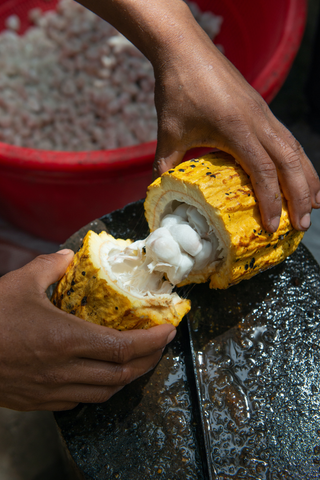
After harvesting, we open the pods to extract the cacao beans. We use machetes, or simply strike the pod against a hard surface to break it open. Inside, the beans are covered in a white pulp, which is sweet and edible. This pulp is the flesh of the cacao fruit, and is instrumental in the fermentation process, as well as being a delicious snack.
Fermentation
The contents of the cacao pod are next loaded into buckets, and then into fermentation boxes called “sweatboxes,” which have gaps between the slats for drainage. After the cacao beans are put into the sweatboxes, they are covered with banana leaves, and the process of anaerobic fermentation begins. The sugars in the pulp quickly convert into alcohol, producing heat that turns the pulp into liquid. During the fermentation process, we turn the pile of cacao beans every two or three days throughout the process (the exact amount of time varies according to the temperature). Stirring the pile encourages aerobic fermentation, which turns the alcohol into acetic acid that gets absorbed by the beans, changing their flavor profile. When the sugars in the fruit are transformed in this way, they give the cacao a richer, sweeter and more complex flavor. During fermentation, the pile reaches a temperature of approximately 50 degrees Celsius.
Drying the Beans
After fermentation is complete, we move the beans from the sweatboxes to our drying area. This greenhouse-like structure offers protection from the elements during this important next step of the process. We turn the beans several times per day until they are completely dry. Generally, the process takes about a week, but a more humid climate will make for a longer drying period.
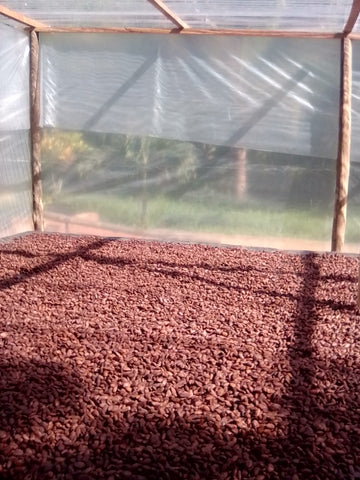
Caption: Cacao beans drying in our newly-constructed covered platform.
Transportation
After the cacao beans are dry, they travel approximately seven hours from the farm in Alta Verapaz to our workshop in Guatemala City, where we sort and inspect the beans. Here, we sieve the cacao using a wire mesh. Anything smaller than a cacao bean falls through and is filtered out. At this stage, we also remove defective beans. Our Cosmic Cacao is almost ready for you!
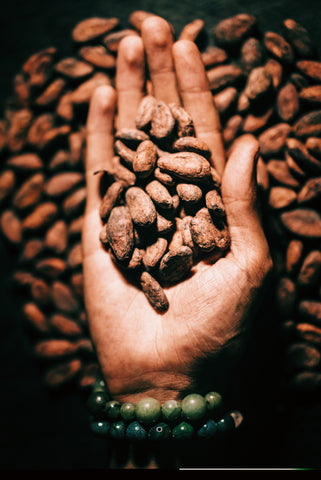
Caption: Dried cacao beans before they are roasted.
Roasting the Beans
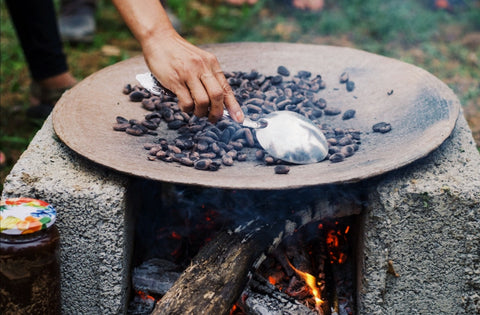
We roast the beans using modified coffee roaster machines, at temperatures around 120-140 degrees Celsius. Lightly roasting the beans kills bacteria on the outer shell, and also helps to develop the flavor profile of the cacao. During the roasting process, some alkaloids are destroyed, while others are created. The length of roasting time and the level of heat affect both the flavor and the psychoactive effects of the cacao. Roasting at these temperatures decreases the “sourness” and astringency of the cacao, and makes the chocolatey flavor bolder.
There is a common misconception about “raw cacao.” Food is considered raw if it is not exposed to heat above 40-45 Celsius. Truly “raw” cacao would be very difficult to digest, and would most likely give you a stomach ache. Most commercial cacao is actually roasted at temperatures of 250-275 degrees Celsius, double the heat at which we roast our Cosmic Cacao. Over-roasting cacao (which we are careful never to do) will give it a burnt flavor and erase the subtleties we love.
Peeling
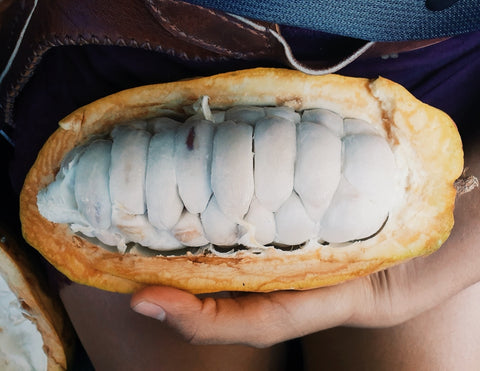
After the cacao seeds are roasted and cooled, we peel the cacao by hand in our workshop. During this stage, we do another round of sorting and remove any defective beans we encounter.
Grinding
Finally, we grind the cacao. We use a machine called a melanger, which provides a very fine grind, reaching a consistency of 25 microns. This gives Cosmic Cacao its smooth, rich texture. A lot of commercial cacao is processed using a corn mill (known in Guatemala as a nixtamal), which gives a coarser grind.
Setting
After going through the melanger, the cacao is hot and liquid. We then pour the liquid cacao into molds, where it sets into solid blocks. After allowing the blocks to set overnight, we package and prepare them for export. From our workshop, orders travel to the storage facilities of our three distributors—one in the United States, one in the European Union, and one in Asia. From there, we ship our Cosmic Cacao to you!
If you want to learn more about the state of the cacao industry today and the abuses that cacao farmers suffer, we recommend that you watch Bitter Chocolate, Season 2, Episode 5 of the Rotten series.
